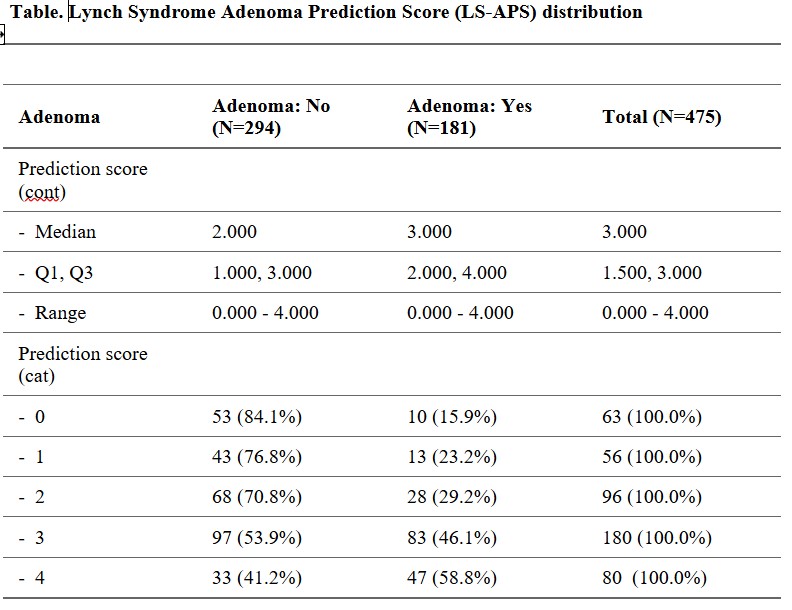Sunday Poster Session
Category: Colorectal Cancer Prevention
P0466 - A Model to Predict Colon Adenomas in Lynch Syndrome Patients
Sunday, October 26, 2025
3:30 PM - 7:00 PM PDT
Location: Exhibit Hall

Rohan D. Patel, MBBS
Mayo Clinic
Camden, DE
Presenting Author(s)
Rohan D. Patel, MBBS1, Kerri Conklin, 2, Zhuo Li, 2, Sophia Blumfield, 2, Bhaumik Brahmbhatt, MBBS, MD2, Douglas Riegert-Johnson, MD2
1Mayo Clinic, Camden, DE; 2Mayo Clinic, Jacksonville, FL
Introduction: Patients with Lynch syndrome have an elevated risk for colon cancer and are recommended to have a colonoscopy every one to three years. Colonoscopy is performed to identify and remove precancerous polyps (adenomas) to prevent colon cancer. Many Lynch syndrome patients are unable to undergo frequent colonoscopy, and some are diagnosed with colon cancer even with frequent colonoscopy. Targeting colonoscopy to Lynch syndrome patients at highest risk for adenoma development would allow for more efficient use of resources and improved cancer prevention. There has been little research on risk factors for adenoma development in Lynch syndrome patients.
Methods: This prospective cohort study collected on individuals with Lynch syndrome having colonoscopy at Mayo Clinic from 2009-2025.
Results: The study dataset included information from 142 individuals with Lynch syndrome who had 475 colonoscopies. Older age, a history of prior colon adenomas and no previous colonoscopy at our center predicted finding an adenoma on colonoscopy. A five tier Lynch syndrome adenoma prediction score (LS-APS) was developed incorporating these factors. LS-APS scoring and corresponding adenoma detection rates were 0 - 15.95%, 1 - 23.2%, 3 - 29.2%, 4 - 46.1%, and 5 - 58.8%. The LS-APS score was a median of 3 for adenoma-positive colonoscopies and 2 for adenoma-negative colonoscopies (p< 0.001).
Discussion: The LS-APS is a simple prediction score based on age and history of prior adenoma can identify LS patients more likely to develop adenomas. Further validation in large, multicenter datasets is needed.

Figure: Distribution of Lynch Syndrome Adenoma Prediction Scores. This table presents the distribution of continuous and categorical prediction scores for individuals with and without adenomas. The continuous prediction score is reported with median, interquartile range (Q1, Q3), and range. The categorical prediction score is shown by the number of individuals within each score category (0-4), with the corresponding percentages for adenoma and non-adenoma groups. The data provides insight into how prediction scores are distributed across individuals with and without adenomas.
Disclosures:
Rohan Patel indicated no relevant financial relationships.
Kerri Conklin indicated no relevant financial relationships.
Zhuo Li indicated no relevant financial relationships.
Sophia Blumfield indicated no relevant financial relationships.
Bhaumik Brahmbhatt indicated no relevant financial relationships.
Douglas Riegert-Johnson indicated no relevant financial relationships.
Rohan D. Patel, MBBS1, Kerri Conklin, 2, Zhuo Li, 2, Sophia Blumfield, 2, Bhaumik Brahmbhatt, MBBS, MD2, Douglas Riegert-Johnson, MD2. P0466 - A Model to Predict Colon Adenomas in Lynch Syndrome Patients, ACG 2025 Annual Scientific Meeting Abstracts. Phoenix, AZ: American College of Gastroenterology.
1Mayo Clinic, Camden, DE; 2Mayo Clinic, Jacksonville, FL
Introduction: Patients with Lynch syndrome have an elevated risk for colon cancer and are recommended to have a colonoscopy every one to three years. Colonoscopy is performed to identify and remove precancerous polyps (adenomas) to prevent colon cancer. Many Lynch syndrome patients are unable to undergo frequent colonoscopy, and some are diagnosed with colon cancer even with frequent colonoscopy. Targeting colonoscopy to Lynch syndrome patients at highest risk for adenoma development would allow for more efficient use of resources and improved cancer prevention. There has been little research on risk factors for adenoma development in Lynch syndrome patients.
Methods: This prospective cohort study collected on individuals with Lynch syndrome having colonoscopy at Mayo Clinic from 2009-2025.
Results: The study dataset included information from 142 individuals with Lynch syndrome who had 475 colonoscopies. Older age, a history of prior colon adenomas and no previous colonoscopy at our center predicted finding an adenoma on colonoscopy. A five tier Lynch syndrome adenoma prediction score (LS-APS) was developed incorporating these factors. LS-APS scoring and corresponding adenoma detection rates were 0 - 15.95%, 1 - 23.2%, 3 - 29.2%, 4 - 46.1%, and 5 - 58.8%. The LS-APS score was a median of 3 for adenoma-positive colonoscopies and 2 for adenoma-negative colonoscopies (p< 0.001).
Discussion: The LS-APS is a simple prediction score based on age and history of prior adenoma can identify LS patients more likely to develop adenomas. Further validation in large, multicenter datasets is needed.

Figure: Distribution of Lynch Syndrome Adenoma Prediction Scores. This table presents the distribution of continuous and categorical prediction scores for individuals with and without adenomas. The continuous prediction score is reported with median, interquartile range (Q1, Q3), and range. The categorical prediction score is shown by the number of individuals within each score category (0-4), with the corresponding percentages for adenoma and non-adenoma groups. The data provides insight into how prediction scores are distributed across individuals with and without adenomas.
Disclosures:
Rohan Patel indicated no relevant financial relationships.
Kerri Conklin indicated no relevant financial relationships.
Zhuo Li indicated no relevant financial relationships.
Sophia Blumfield indicated no relevant financial relationships.
Bhaumik Brahmbhatt indicated no relevant financial relationships.
Douglas Riegert-Johnson indicated no relevant financial relationships.
Rohan D. Patel, MBBS1, Kerri Conklin, 2, Zhuo Li, 2, Sophia Blumfield, 2, Bhaumik Brahmbhatt, MBBS, MD2, Douglas Riegert-Johnson, MD2. P0466 - A Model to Predict Colon Adenomas in Lynch Syndrome Patients, ACG 2025 Annual Scientific Meeting Abstracts. Phoenix, AZ: American College of Gastroenterology.
